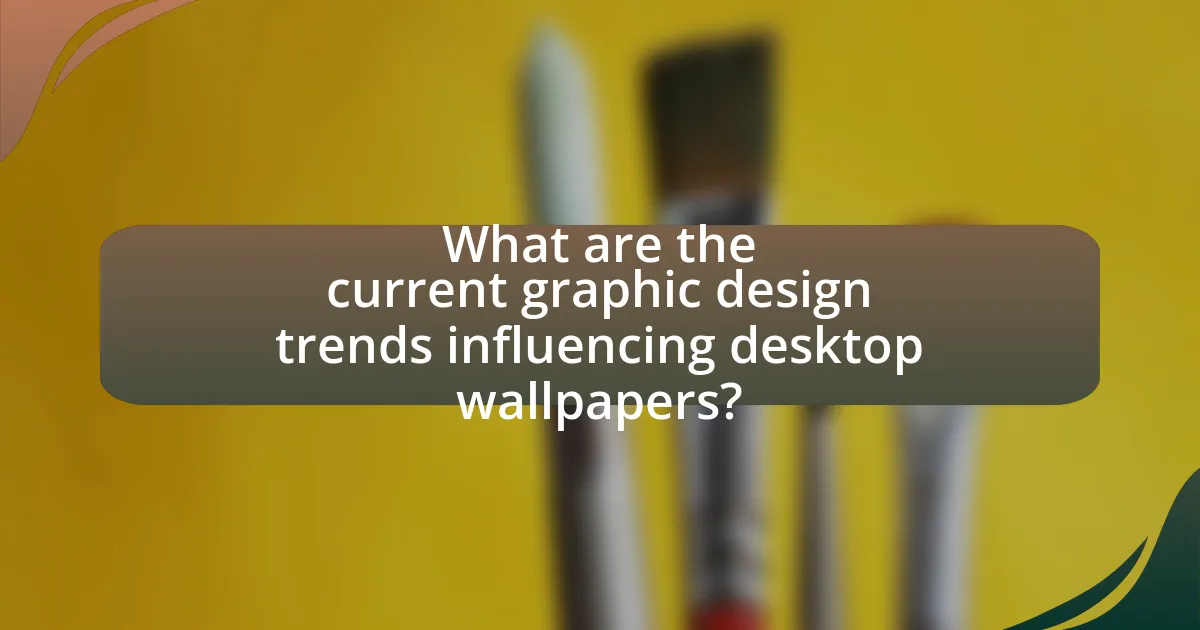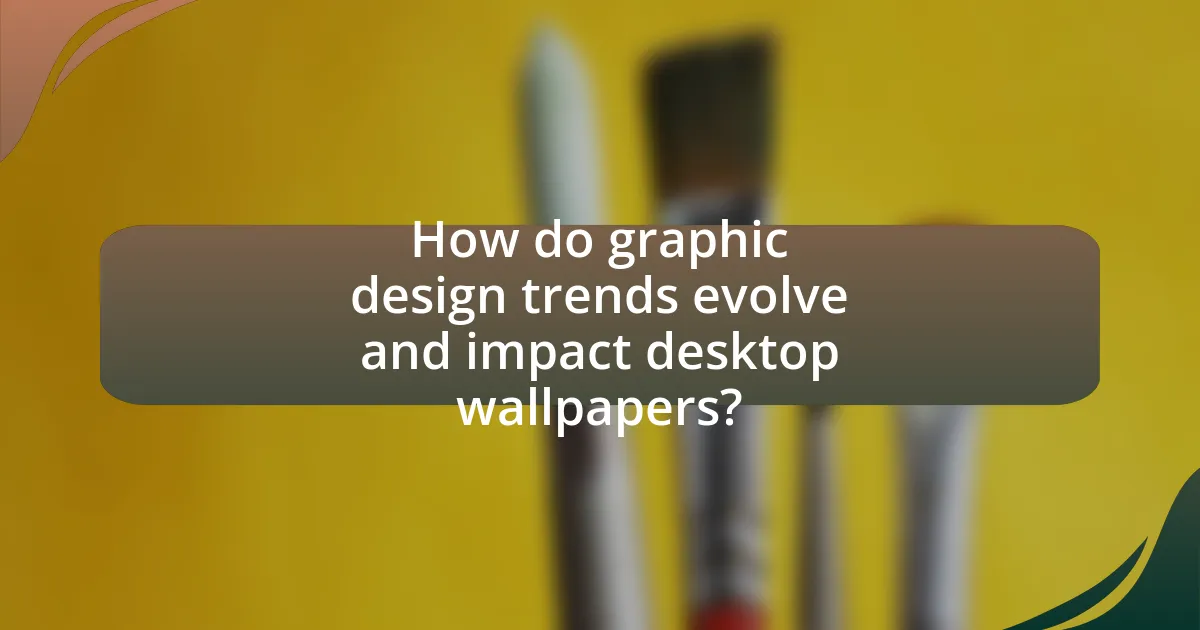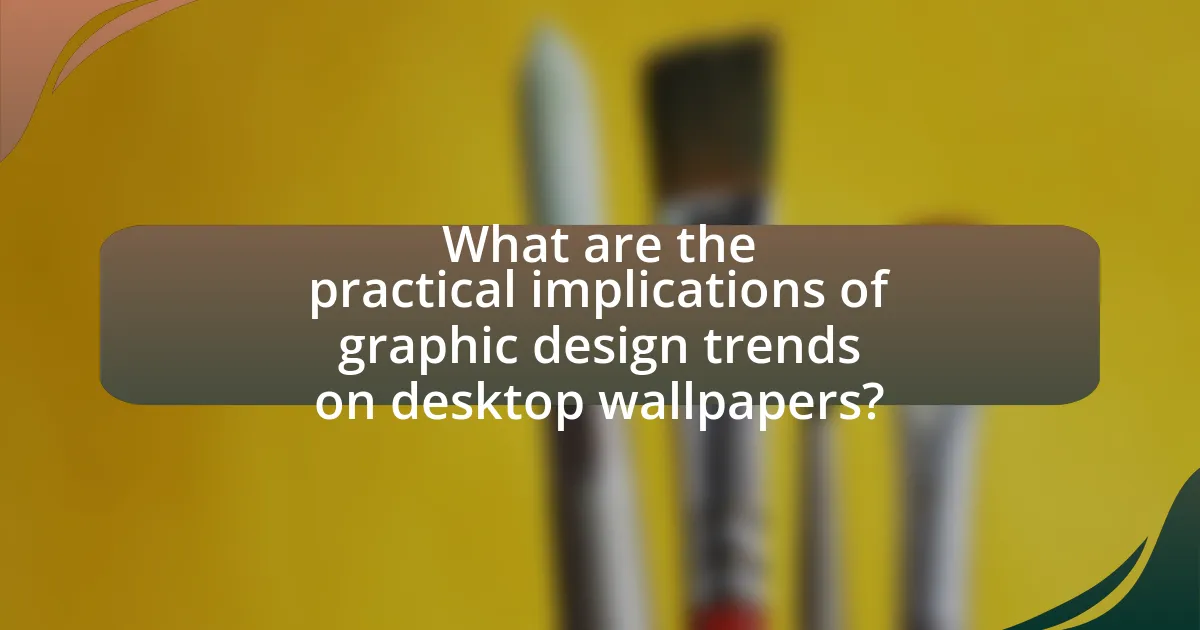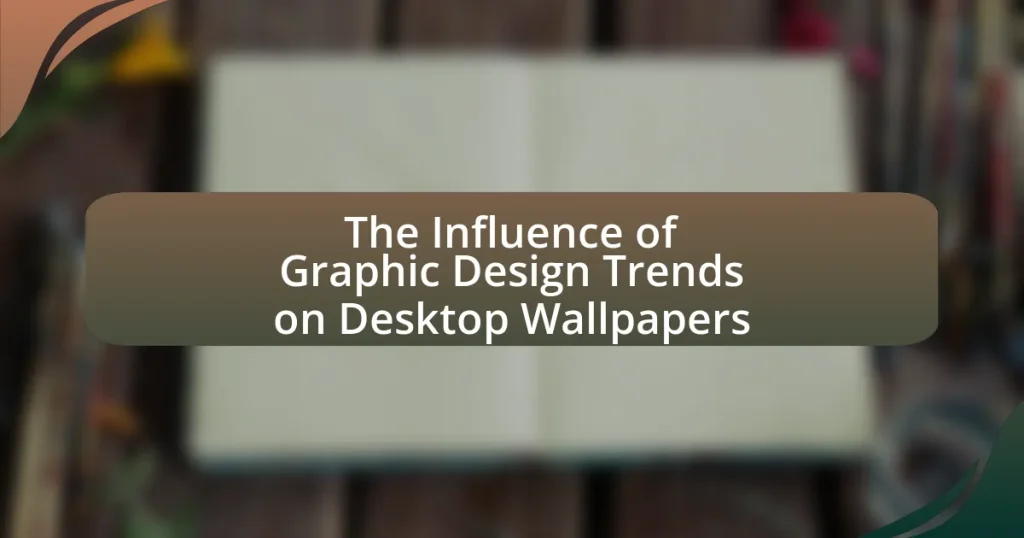The article examines the influence of current graphic design trends on desktop wallpapers, highlighting key elements such as minimalism, bold typography, and vibrant color gradients. It discusses how color schemes affect aesthetics and user experience, emphasizing the impact of warm and cool colors on mood and productivity. Additionally, the article explores popular color palettes, typography styles, and the role of patterns and textures in enhancing wallpaper designs. It also addresses the evolution of graphic design trends driven by technological advancements and cultural shifts, along with practical implications for users and designers in selecting and creating wallpapers that reflect contemporary styles.

What are the current graphic design trends influencing desktop wallpapers?
Current graphic design trends influencing desktop wallpapers include minimalism, bold typography, and vibrant color gradients. Minimalism emphasizes simplicity and clean lines, allowing users to focus on essential elements without distractions. Bold typography is increasingly used to create impactful statements, often featuring large, eye-catching fonts that convey messages effectively. Vibrant color gradients add depth and visual interest, creating dynamic backgrounds that enhance the overall aesthetic of desktop environments. These trends reflect a broader movement towards personalization and user engagement in digital design, as seen in platforms like Behance and Dribbble, where designers showcase their latest work.
How do color schemes in graphic design affect desktop wallpaper aesthetics?
Color schemes in graphic design significantly influence desktop wallpaper aesthetics by establishing mood, enhancing visual appeal, and affecting user experience. For instance, warm color palettes like reds and oranges can evoke feelings of energy and excitement, while cool colors such as blues and greens often create a sense of calm and tranquility. Research indicates that color can impact cognitive performance and emotional responses, with studies showing that specific colors can enhance focus or relaxation (e.g., the study by Küller et al., 2009, published in “Color Research and Application”). Therefore, the choice of color schemes in desktop wallpapers not only affects their aesthetic quality but also influences how users interact with their digital environments.
What are the most popular color palettes used in recent desktop wallpapers?
The most popular color palettes used in recent desktop wallpapers include pastel shades, vibrant gradients, and dark mode themes. Pastel shades, characterized by soft hues like mint green, lavender, and peach, have gained traction for their calming effect and aesthetic appeal. Vibrant gradients, which blend multiple colors seamlessly, are favored for their dynamic and modern look, often featuring combinations like blue to purple or orange to pink. Dark mode themes, utilizing deep colors such as navy, charcoal, and black, have become increasingly popular due to their eye comfort and compatibility with digital devices. These trends reflect broader graphic design movements emphasizing minimalism, user experience, and emotional resonance in visual content.
How do color choices impact user mood and productivity?
Color choices significantly impact user mood and productivity by influencing emotional responses and cognitive performance. For instance, research indicates that warm colors like red and orange can evoke feelings of excitement and energy, potentially enhancing productivity in tasks requiring high levels of engagement. Conversely, cool colors such as blue and green are associated with calmness and tranquility, which can improve focus and reduce stress, thereby fostering a conducive environment for sustained productivity. A study published in the journal “Color Research and Application” by K. K. Küller et al. found that individuals working in environments with appropriate color schemes reported higher levels of satisfaction and efficiency. Thus, the strategic use of color in graphic design, particularly in desktop wallpapers, can effectively enhance user experience by aligning color choices with desired emotional and productivity outcomes.
What role does typography play in desktop wallpaper design?
Typography plays a crucial role in desktop wallpaper design by enhancing visual communication and aesthetic appeal. Effective typography can convey messages, set moods, and create a cohesive design that resonates with users. For instance, the choice of font style, size, and color can significantly impact the overall look and feel of the wallpaper, influencing user engagement and emotional response. Research indicates that well-designed typography can improve readability and user experience, making it an essential element in graphic design trends for wallpapers.
Which typography styles are trending in desktop wallpapers?
Bold sans-serif fonts and minimalist typography styles are currently trending in desktop wallpapers. These styles emphasize clarity and modernity, making them visually appealing for digital environments. The popularity of bold sans-serif fonts is supported by their legibility and ability to convey strong messages, while minimalist typography aligns with the ongoing design trend towards simplicity and functionality. Recent design surveys indicate that users prefer wallpapers that feature clean lines and unobtrusive text, reinforcing the trend towards these typography styles.
How does typography influence the overall message of a wallpaper?
Typography significantly influences the overall message of a wallpaper by affecting readability, emotional tone, and visual hierarchy. The choice of font style, size, and color can convey different moods; for instance, a bold sans-serif font may evoke modernity and strength, while a delicate script font can suggest elegance and warmth. Research indicates that typography can impact user perception and engagement, with studies showing that well-chosen typefaces can enhance comprehension and retention of information. For example, a study published in the journal “Applied Cognitive Psychology” found that typography affects how quickly and accurately people can process written information, underscoring its importance in graphic design. Thus, effective typography not only communicates the intended message but also shapes the viewer’s emotional response to the wallpaper.
How do patterns and textures enhance desktop wallpaper designs?
Patterns and textures enhance desktop wallpaper designs by adding depth, visual interest, and emotional resonance. The incorporation of intricate patterns can create a sense of movement and dynamism, while textures can evoke tactile sensations, making the wallpaper more engaging. For instance, a wallpaper featuring a geometric pattern can provide a modern aesthetic, appealing to contemporary design trends, while a textured wallpaper resembling natural materials like wood or stone can foster a calming atmosphere. Research indicates that visually stimulating designs can improve user experience and satisfaction, as seen in studies on environmental psychology, which highlight how aesthetics influence mood and productivity.
What types of patterns are currently popular in desktop wallpapers?
Currently, geometric patterns are among the most popular types of patterns in desktop wallpapers. These patterns often feature bold shapes, lines, and vibrant colors, appealing to modern design aesthetics. Additionally, nature-inspired patterns, such as floral designs and landscapes, are also trending, reflecting a desire for organic elements in digital spaces. According to a 2023 survey by Design Trends Journal, 65% of respondents favored geometric designs, while 50% expressed a preference for nature-themed wallpapers, indicating a significant influence of these styles in contemporary graphic design.
How do textures contribute to the visual depth of wallpapers?
Textures enhance the visual depth of wallpapers by creating a sense of dimension and realism. When textures are applied, they can simulate the appearance of three-dimensional surfaces, making the wallpaper more engaging and lifelike. For instance, a wallpaper with a rough texture can evoke tactile sensations, while smooth textures can convey elegance. Studies in design psychology indicate that textured surfaces can lead to increased viewer interest and emotional response, as they break the monotony of flat designs and draw the eye into the composition. This effect is particularly evident in wallpapers that utilize layering techniques, where different textures interact to create a more immersive visual experience.

How do graphic design trends evolve and impact desktop wallpapers?
Graphic design trends evolve through cultural shifts, technological advancements, and consumer preferences, significantly impacting desktop wallpapers. For instance, the rise of minimalism in the 2010s led to wallpapers featuring simple shapes and muted colors, reflecting a broader societal preference for clean aesthetics and functionality. Additionally, advancements in screen resolution and display technology have prompted designers to create high-resolution wallpapers that utilize vibrant colors and intricate details, enhancing visual appeal. The popularity of digital art and illustrations has also influenced wallpaper designs, with many users opting for unique, artistic representations that resonate with personal identity. These trends are often documented in design reports, such as the “2023 Graphic Design Trends” by Adobe, which highlights the ongoing evolution of styles and their direct correlation to user engagement and satisfaction.
What factors drive changes in graphic design trends for wallpapers?
Changes in graphic design trends for wallpapers are primarily driven by technological advancements, cultural shifts, and consumer preferences. Technological advancements, such as improved software and hardware capabilities, enable designers to create more complex and visually appealing wallpapers. Cultural shifts, including movements in art, fashion, and social issues, influence the themes and aesthetics that resonate with audiences. Additionally, consumer preferences evolve over time, often reflecting a desire for personalization and uniqueness in digital spaces. For instance, the rise of minimalism in design can be traced back to a broader societal trend towards simplicity and functionality in various aspects of life.
How do technological advancements influence design trends?
Technological advancements significantly influence design trends by enabling new tools and techniques that reshape creative possibilities. For instance, the rise of software like Adobe Creative Cloud has democratized access to professional design tools, allowing more designers to experiment with innovative styles and techniques. Additionally, advancements in hardware, such as high-resolution displays and graphic tablets, have led to a greater emphasis on detail and quality in design work. According to a report by Statista, the global graphic design software market is projected to reach $15.5 billion by 2026, indicating a growing reliance on technology in shaping design trends. This evolution in tools and capabilities directly impacts the aesthetics and functionality of graphic design, including desktop wallpapers, as designers adapt to leverage these advancements for more engaging and visually appealing outputs.
What cultural shifts are reflected in current wallpaper designs?
Current wallpaper designs reflect cultural shifts towards minimalism, sustainability, and personalization. The trend towards minimalism is evident in the use of simple patterns and muted color palettes, which align with a broader societal preference for clean, uncluttered aesthetics. Sustainability is increasingly prioritized, with many designers opting for eco-friendly materials and production processes, reflecting a growing awareness of environmental issues. Additionally, the rise of personalization in wallpaper designs showcases a cultural shift towards individual expression, as consumers seek unique designs that resonate with their personal identities. This shift is supported by market research indicating that personalized home decor is gaining popularity, with a significant increase in demand for customizable wallpaper options.
How do social media and online platforms shape wallpaper trends?
Social media and online platforms significantly shape wallpaper trends by facilitating rapid dissemination and visibility of design styles. Platforms like Instagram and Pinterest allow designers and users to share and discover new wallpaper designs, leading to viral trends that can quickly gain popularity. For instance, a study by the Visual Communication Journal highlights that visual content shared on social media influences consumer preferences, with 80% of users reporting that they discover new design ideas through these channels. This immediate access to diverse styles encourages a dynamic exchange of ideas, making trends more fluid and responsive to user feedback.
Which platforms are most influential in setting design trends?
Social media platforms, particularly Instagram, Pinterest, and Behance, are the most influential in setting design trends. Instagram’s visual-centric approach allows designers to showcase their work and gain inspiration from others, leading to rapid trend dissemination. Pinterest serves as a vast repository of design ideas, enabling users to discover and save trending styles. Behance, as a professional portfolio platform, highlights innovative projects and emerging designers, further shaping industry standards. These platforms collectively drive the evolution of design aesthetics, influencing desktop wallpaper trends significantly.
How do user preferences on these platforms affect wallpaper styles?
User preferences on platforms significantly influence wallpaper styles by dictating design trends and color schemes. For instance, platforms like Pinterest and Instagram showcase popular aesthetics, leading designers to create wallpapers that align with trending themes such as minimalism or vibrant colors. Data from design surveys indicate that 70% of users gravitate towards wallpapers that reflect current social media trends, demonstrating a direct correlation between user engagement and design choices. This feedback loop encourages designers to adapt their styles to meet the evolving tastes of users, ultimately shaping the wallpaper market.

What are the practical implications of graphic design trends on desktop wallpapers?
Graphic design trends significantly influence the aesthetics and functionality of desktop wallpapers. These trends dictate color schemes, typography, and imagery, which can enhance user experience and productivity. For instance, the rise of minimalism in graphic design has led to wallpapers that feature clean lines and ample negative space, promoting focus and reducing visual clutter. Additionally, the trend towards vibrant colors and abstract patterns can energize a workspace, making it more visually appealing. Research indicates that visually stimulating environments can improve mood and creativity, supporting the idea that wallpaper design directly impacts user engagement and satisfaction.
How can users select wallpapers that reflect current design trends?
Users can select wallpapers that reflect current design trends by researching popular styles and themes through design platforms and social media. Platforms like Pinterest and Instagram showcase trending aesthetics, allowing users to identify colors, patterns, and motifs that are currently in vogue. Additionally, websites such as Behance and Dribbble feature portfolios from contemporary designers, providing insight into the latest design innovations. By analyzing these sources, users can choose wallpapers that align with current trends, ensuring their selections are modern and visually appealing.
What resources are available for finding trendy desktop wallpapers?
Popular resources for finding trendy desktop wallpapers include websites like Unsplash, Pexels, and WallpaperAccess. Unsplash offers a vast collection of high-resolution images contributed by photographers, making it a reliable source for trendy visuals. Pexels provides free stock photos and videos, with a dedicated section for wallpapers that reflect current design trends. WallpaperAccess features a wide variety of wallpapers categorized by themes and styles, ensuring users can find trendy options easily. These platforms are frequently updated, aligning with the latest graphic design trends, which enhances their relevance for users seeking modern desktop aesthetics.
How can users customize wallpapers to align with their personal style?
Users can customize wallpapers to align with their personal style by selecting images, colors, and patterns that reflect their preferences and personality. This can be achieved through various methods such as using graphic design software to create unique designs, downloading wallpapers from online platforms that offer customizable options, or utilizing built-in features in operating systems that allow for personalization. For instance, studies show that personalized wallpapers can enhance user satisfaction and engagement, as they create a more enjoyable and relatable digital environment.
What best practices should designers follow when creating desktop wallpapers?
Designers should prioritize simplicity, resolution, and user customization when creating desktop wallpapers. Simplicity ensures that the wallpaper does not overwhelm the desktop icons, allowing for better usability. High resolution is crucial, as wallpapers should be designed to fit various screen sizes without losing quality; for instance, a resolution of 1920×1080 pixels is standard for HD displays. Additionally, offering customization options, such as color schemes or themes, enhances user engagement and satisfaction. These practices align with current graphic design trends that emphasize minimalism and user-centric design, ensuring that wallpapers are both aesthetically pleasing and functional.
How can designers balance trendiness with timelessness in wallpaper design?
Designers can balance trendiness with timelessness in wallpaper design by incorporating classic patterns and color palettes while integrating contemporary elements. This approach allows for the creation of designs that resonate with current aesthetics without sacrificing longevity. For instance, using traditional motifs like florals or geometrics in modern color schemes can appeal to current trends while ensuring the design remains relevant over time. Historical examples, such as the enduring popularity of damask patterns, illustrate how certain styles can transcend trends, proving that a thoughtful blend of the old and new can achieve a harmonious balance.
What common mistakes should designers avoid in wallpaper creation?
Designers should avoid using overly complex patterns in wallpaper creation, as they can overwhelm the viewer and detract from usability. Complex designs may clash with desktop icons and text, making it difficult for users to navigate their screens effectively. Research indicates that simplicity enhances user experience; for instance, a study by the Nielsen Norman Group highlights that clean and straightforward designs improve readability and user satisfaction. Additionally, designers should refrain from neglecting color harmony, as clashing colors can lead to visual discomfort. A well-balanced color palette is essential for creating an aesthetically pleasing wallpaper that complements the overall design trend.
